The Japanese maple dilemma
February 6, 2013 @ 11:12 am
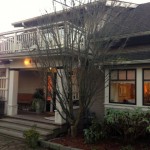 Here was the dilemma: one of our clients had a gorgeous Lions Head Japanese maple that had grown too big for its location. It was already 7 feet tall when the homeowner planted it on his property 12 years ago, so you can imagine how much it had grown since.
Here was the dilemma: one of our clients had a gorgeous Lions Head Japanese maple that had grown too big for its location. It was already 7 feet tall when the homeowner planted it on his property 12 years ago, so you can imagine how much it had grown since.
Our client was looking to move the maple because it was planted too close to the house; its roots were likely to get tangled in underground gas lines and the top branches would soon interfere with overhead cable lines. He also had a personal attachment to the tree, so wanted to find a way to preserve it if possible. And what’s not to love about it: this deciduous tree has beautiful green foliage that turns red in spring and a spectacular gold in the fall. It can grow to about 20 feet tall at maturity with a spread of about 15 feet.
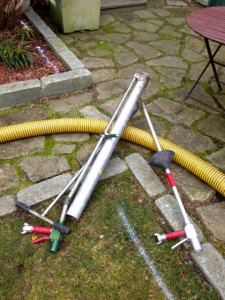
Air vaccum and air knife. All photos by Ecoyards
The problem: the roots of the Lions Head Japanese Maple were so close to gas lines that we couldn’t dig it out without striking those lines and causing all kinds of mayhem.
The solution: we hired an arborist who used “an air knife” to safely excavate soil from the maple’s tree roots without having to hack away with a pick or shovel and otherwise damaging the roots.
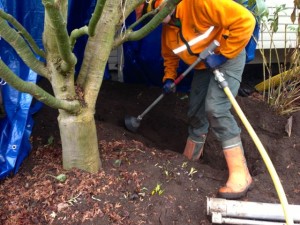
Opening up root-ball with air knife.
The air knife uses compressed air (not unlike air tire pumps you find at gas stations) at about 185 psi rating. The pressure from the air knife removes soil away by focusing a stream of air around the roots. Apparently, this technology has been used by the military to excavate land mines.
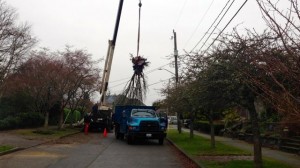
Crane places tree in truck for move.
The process of air-excavating the tree from its original location was tedious. It took hours to gently remove the soil away from the root ball. Once we had freed the soil from the root ball, we brought in a crane to raise the plant and moved it into a truck where we then transplanted it into its new location.
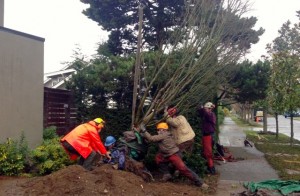
Crew places Lions Head Japanese Maple in its new location.
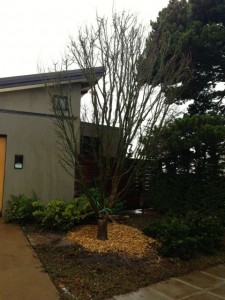
Happy tree in its new location. This maple, Acer palmatum “Shishigashira”, loves full sun to partial shade, and is relatively low maintenance. It can live to be about 80 years old!
Contact Ecoyards if you ever need help solving a tricky landscaping situation.
Filed under Seattle Landscape Maintenance Permalink · No Comments »
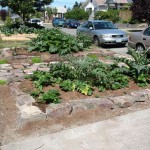 Fortunately, the city of Seattle has been encouraging residents to plant urban gardens for a number of years as the urban farm movement has taken hold. The mayor and others even
Fortunately, the city of Seattle has been encouraging residents to plant urban gardens for a number of years as the urban farm movement has taken hold. The mayor and others even 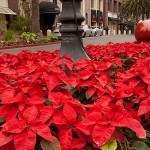

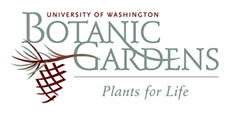 If you’ve ever wondered what kind of tree or shrub is growing in your backyard, or if you covet your neighbor’s flower but its name stumps you, look no further. The plant detectives at the
If you’ve ever wondered what kind of tree or shrub is growing in your backyard, or if you covet your neighbor’s flower but its name stumps you, look no further. The plant detectives at the 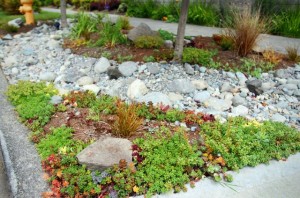


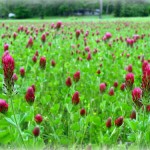
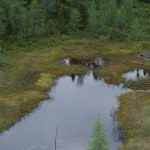
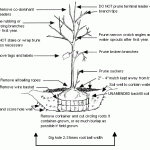 The cooler weather in Seattle means it’s time to plant trees! Fall is a great time to do this, because the weather is much cooler and this allows trees and plants to establish new roots rather than withering in dry, summer conditions.
The cooler weather in Seattle means it’s time to plant trees! Fall is a great time to do this, because the weather is much cooler and this allows trees and plants to establish new roots rather than withering in dry, summer conditions.


